In reply to NickD :
The 425 looks like its on a different track in the background.
In reply to DjGreggieP :
Reading T-1s are about average in terms of size for a Northern, but #425 is quite small for a Pacific. She only has 68" drivers (#2102, a freight engine, has 70" drivers) and is 30 tons lighter than even a USRA Light Pacific. She makes up for it with a lot of charm and attitude though.
I was hoping to get to see #425 this year and maybe ride in the cab (R&N sells cab ride tickets on the Lehigh Gorge Scenic trips for $100) or at least spend a weekend photographing those runs, since #425 is due for an FRA inspection at the end of this year. But from what I heard, they've already taken #425 out of service to begin work.
The good news is, #2102 isn't supplanting #425. The #425 is going to be used on shorter trips, like Lehigh Gorge Scenic, while #2102 will be used for long hauls
Cumbres & Toltec Scenic Railroad, operator of the old D&RGW narrow gauge line from Chama, New Mexico to Antonito, Colorado, has voted to restore one of their two K-37 Mikados, either #492 or #497, to service. C&TS currently operates four of the slightly smaller K-36, #484, #487, #488 and #489, and one of the much smaller K-27s, #463, along with T-12 Ten-Wheeler #168 and C-18 Consolidation #315 on special occasions. Apparently things are good enough to warrant bring another big engine back to life, and while they have K-36 #483, historically significant for pulling the last passenger train over the line under the D&RGW in 1965, the last freight train over the line under the D&RGW in '68, and the first Cumbres & Toltec Scenic train in 1970, it is supposedly "completely worn out" and has been out of service since 1977. So if they want a bigger engine, they have to turn to the K-37s, which were built after the K-36s, using boilers off of older standard gauge Consolidations.
The #492 has not operated since 1968, when the D&RGW shut down operations in 1968. It's been sitting outdoors in a state of neglect ever since. I really have to wonder, is this engine that much less work to restore than the supposedly "completely worn out" #483? I can't imagine so.
The #497 was returned to operation by Durango & Silverton Narrow Gauge in 1984 but was found to be hard on the track and had issues navigating the Animas River Canyon, leading to an assumption that this was an issue endemic to all K-37s and resulting in D&SNG not wanting anything to do with K-37s for decades. It was instead traded off to C&TS for K-36 #482 and was operated until 2002, at which point it was taken out of service and has been stored inside the Chama, NM roundhouse. It was also discovered that the issues Durango & Silverton had were not an issue with all K-37s, but actually isolated to an issue with the #497's trailing truck, although by that point, D&SNG had traded off the #499 as well. It wasn't until two years ago that D&SNG dipped their toes back in the water with the restoration of #493.

It's great to see that another K-37 will be returned to service, but it is a bit of a headscratcher. Why consider #492, which has been out of service and sitting outdoors for 54 years, when there is the #497, which ran up until two decades ago and has been stored inside since? And if #492 is on the table, why not the #483, which is historically significant to the line and really can't be that much worse off than the #492? I don't have an answer to the first question, but since all the D&RGW narrow gauge equipment was wrecked or damaged at some point in it's life, maybe the #497 has some issues related to collision damage that they are concerned about. I believe the second question is answered by #492 adding to more variety on the C&TS. With a K-37 operating, they will have a T-12, a C-18, a K-27, a K-36, and a K-37 all operating, representatives of all but one class of narrow gauge equipment operated by D&RGW narrow gauge. The only thing they are missing is a K-28, which they tried to get by trading the #483 for the #476 years ago and promptly ran into roadblocks on both sides
Reading #2102 rolling through Tamaqua, PA on one of the original Reading Iron Horse Rambles. This curve was part of the Y to Pottsville, and while R&N still serves Tamaqua and Pottsville, this was realigned several years after this photo to avoid running up Main Street, so sadly this photo can't be replicated.
Some early footage of #425 off of the Blue Mountain & Reading rails, running between Hoboken and Port Jervis in 1986. #425 had been back in service less than a year, and was in black paint with the high headlamp and a PRR 3-chime whistle. That looks like the auxiliary tender built out of a PRR E6s Atlantic tender that sits as a billboard these days. I've heard there were some sort of compatibility issues with it and #425, but it was used behind #2102 on her trips over Conrail. I don't know when the last time #425 ventured off the BM&R/RBM&N/R&N was. Maybe the Steamtown opening weekend in '95 when it sat on display after Steamtown and Andy Muller got in a dispute and Steamtown wouldn't allow it to operate over their rails? Also, this would be over either NJT or Conrail. Whichever rail it was, future trips on that territory got blown to hell by the disastrous 1988 NRHS convention. Conrail and NJT were so outright peeved about how poorly the NRHS convention ran that they refused to allow excursions over their rails for many years afterwards. It took considerable cajoling by Ross Rowland to get NJT to let him run C&O #614 on trips out of Port Jervis, and that was nearly a decade later.
A leased NJTransit GP40-2 on the Middletown & New Jersey passing by the ex-NYO&W station in Middletown, NY over a rare active stretch of ex-NYO&W trackage. Middletown Station is the largest surviving NYO&W structure, and saw it's last passenger train in 1953, when the NYO&W abandoned passenger service after a long period of decline. It also served as the company headquarters in the later years, when the NYO&W moved their main offices out of New York City as a cost-cutting measure. After the NYO&W abandoned in 1957, it served as a restaurant, a nightclub and office space at various times before eventually being fully vacated, then suffering a fire in the mid-2000s. Over the years there have been many proposals to renovate and restore the building and use it as a medical center or municipal offices, amongst other purposes, but all fell flat. There's always been a sense of resignation over the building, that sooner or later it was either going to fall in, be burned down the rest of the way, or be demolished. But recently the mayor of Middletown has announced that the city has raised $9 million and is actually going forward with renovations.

A pair of NYO&W F3s at Middletown station in June of 1953, just 3 months before the end of passenger service.
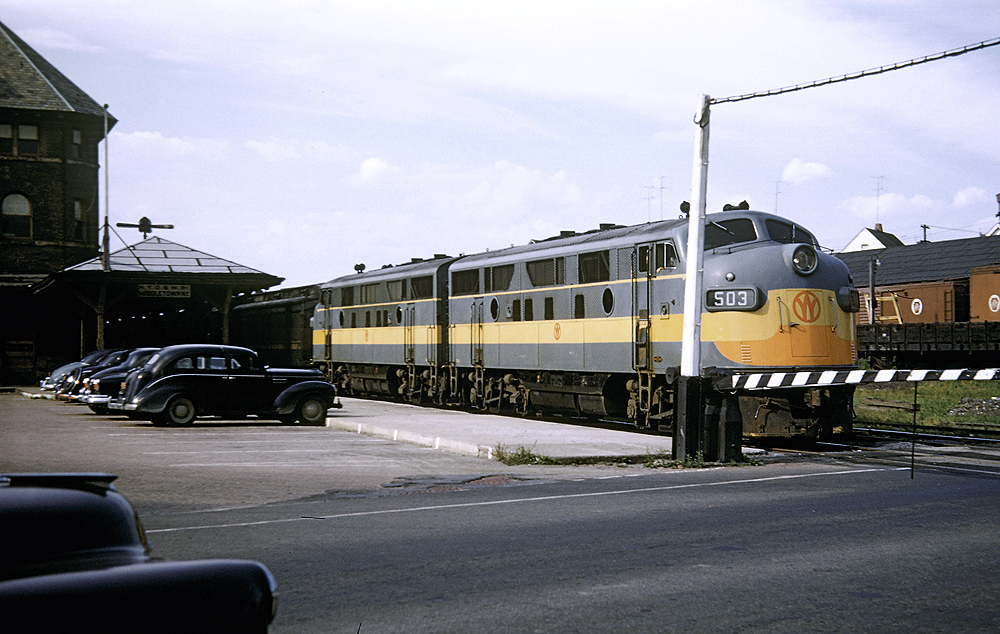
A weird twist of fate is that Middletown & New Jersey, which operates the old NYO&W line through Middletown, has an ex-Quebec, North Shore & Labrador GP9 on their roster. EMD actually had a catalog of liveries that were designed in-house by EMD stylists for railroads that didn't want to design their own, and the NYO&W's gray, yellow, and orange that was used on their NW-2s, FTs and F3s was one of those pre-designed liveries. When Quebec, North Shore & Labrador ordered GP7s and GP9s, the QNS&L also decided not to design their own livery and just happened to pick the same pre-designed livery as the NYO&W. Since the NYO&W never ordered any diesels after their 1948 order of F3s, they never owned any Geeps, but the QNS&L GP7s and GP9s give a glimpse at what they might of looked like.

By the time the one ended up on the M&NJ though, it had passed through several owners, the most recent being Amtrak, and so it didn't wear the QNS&L/NYO&W orange, gray and yellow but instead was in Amtrak MoW silver and black.
I've lived in the South since 1996, had no idea the old Middletown station was even still standing. I thought it had been torn down years ago! Hopefully they can resurrect it.
Lou Manglass
In reply to TheMagicRatchet :
Yep, still standing, against the odds. Sadly, what was left of the Middletown locomotive shop complex burned last year though. The only other big NYO&W structure still standing is the freight house in Utica, which is now an artist's loft. The last roundhouse, or at least three stalls of it, were here in Rome. The turntable pit had been filled, and the roof was completely non-existent, but the walls were still really sound. They demolished it in 2014. There's a number of the smaller depots still in existence, like at Munnsville and Deansboro.
An NYO&W Class U 2-6-0 hustles a 14-car freight along the Middletown & Unionville Railroad. The M&U connected with the Erie and the NYO&W at Middletown, and the NYS&W at Hanford Junction. O&W power did traverse the M&U on occasion to make interchanges with the NYS&W, and was also leased by the M&U. The Middletown & Unionville still exists today, becoming the Middletown & New Jersey in 1947 when it was sold at a foreclosure sale.
Another shortline closely associated with the NYO&W was the Unadilla Valley Railroad, nicknamed "The Dilly-Dally". Built in 1895, it stretched from New Berlin, NY to Bridgewater, NY, following the route of the namesake Unadilla Valley. It had interchanges at New Berlin with NYO&W and at Bridgewater with the DL&W. It operated secondhand O&W steam locomotives and owned a used NYO&W bobber caboose that still exists at the Delaware & Ulster Railroad today.

Mixed Train Daily recounts the amusing circumstances in which the NYO&W burned it's bridges with the town of New Berlin. When New Berlin was to host it's first opera, it was quite a large event, with many of the citizens traveling to Utica to get all done up in preparation. Everyone was ready and waiting at 7pm, when the opera was supposed to start. The hour came and went, then it was 8pm, then 8:30pm, and still no opera troupe. Finally they came rushing in at 8:45pm, almost two hours late. Someone learned that an NYO&W employee had convinced the opera troupe to travel to New Berlin over the convoluted NYO&W, rather than the much faster DL&W to Bridgewater, and then the UV to New Berlin. The people of New Berlin swore from then on not to give the NYO&W any freight or passenger business that could otherwise be routed over the UV/DL&W.
In 1941, the NYO&W actually sold their New Berlin Branch, which went from Cooperstown Junction to New Berlin on to Edmeston, doubling the UV's mileage pretty much overnight. The UV would purchase a Brill motorcar to handle passenger service, but the ICC actually forced the UV to end their passenger service, after a spectacular cornfield meet between the Brill and one of their steam locomotives. ICC investigators were so baffled as to how the collision occurred, with the UV operating a pretty sparse schedule, that they decided it was best if the UV didn't operate passenger service anymore. The ex-NYO&W steam engines stayed on the roster until 1956, nearly outliving the O&W itself, but were joined by GE 70-tonners in 1947.

The Unadilla Valley actually had plans for further expansion in 1958. The O&W had abandoned in 1957, costing the UV one of it's interchange partners. With O&W equipment and trackage up for grabs, the UV purchased three ex-NYO&W EMD NW-2 switchers, #111-#113, and had them moved onto the property. The owners of the Unadilla Valley, the H. E. Salzberg Company (making it one of very few Jewish-owned railroads in the US at the time) desired a link from New Berlin Junction to Sidney, NY, to connect with the Delaware & Hudson Railroad, and also to reach to Norwich, NY, for connection with the DL&W RR. The very recently abandoned but still intact O&W rail line between Sidney, NY, and Norwich, NY were up for grabs, and they would need more horsepower for this planned expansion. It was an interesting idea, but it never materialized in the end, and the three O&W locomotives harbored in the UV rail yard, unused, in New Berlin. Weighing over 50 tons more than the GE 70-tonners, the NW-2s were used on a few occasions, but had issues with breaking the light 70lb rail of the UV and were sold off a year later to the Rock Island in 1959. One year later, the UV filed for abandonment and was granted permission by the ICC, and ceased to exist.
106ft long weighing 856,000 pounds generating 6,000hp. C&O turbine, the last gasp of steam, a traditional boiler spinning a steam turbine, turning a generator to power traction motors.
In reply to 914Driver :
The fact that the train it was built for, Chesapeake & Ohio's ultra-luxury Chessie, was canceled before it ever turned a wheel was probably an ominous sign that the M-1 turbines were not going to live a long and prosperous life. They were a fragile and complicated machine in an environment that did not take kindly to such things. The jarring, vibrations, and impacts damaged the turbine themselves, while coal dust and leaking water frequently shorted out the traction motors.


Union Pacific tried building a coal turbine locomotive in 1962. Unlike the C&O M-1 or N&W Jawn Henry this was not a coal-fired steam-driven turbine, it used coal dust to fuel the turbine. It was a freakish, 3-unit machine that looked like something out of a sci-fi move. The lead control unit was built from an Alco PA, and retained the 2000hp 244 engine and A1A trucks. The second unit was built on the chassis of a Great Northern W-1 electric and had the turbine from a second-generation UP gas turbine electric, modified to burn coal dust. The tender was from a UP 3900 series tender, converted to a giant coal bunker. With 7000hp total, 2000 from the control unit and 5000hp from the turbine, and an A1A-A1A+2-D+D-2 wheel arrangement, it was a huge machine. It also proved to be hideously unreliable. Most of the issues were related to erosion of the turbine blades, ash deposits on the turbine blades, and difficulties with crushing coal into fine enough particles. After less than 10000 miles and 20 months, UP gave up on it. The control unit was traded in to EMD and the rest was scrapped at Omaha.

UP actually tried a steam turbine electric as early as '38. Already toying with distillate and diesel powered trainsets, UP teamed up with GE to develop two oil-fired steam turbine locomotives, with a 2-C-C-2 wheel arrangement, 2500hp, and bulbous styling evocative of the M-10000 and it's ilk. Despite much publicity, including a personal inspection by FDR and an appearance in Cecil DeMille's Union Pacific they were poorly received by the railroad. They were plagued with all the issues typical of later steam turbine electrics and UP never entered them into regular service. In 1939, UP sent them back to GE for improvement but then fully abandoned the project in '41. They made some test runs on the New York Central in 1941 and clearly failed to garner any interest there. They resurfaced again in '43 when they were loaned to Great Northern to ease a WWII-induced power shortage, then were retired from service later that year. The exact date they were scrapped is unknown but it was sometime before the end of the year.

Union Pacific rebuilt one of their first-generation gas turbine electrics, the #57, to run on propane instead of the standard Bunker C fuel oil. They found that while propane was much cleaner burning and less prone to fouling the turbine blades, the specialized handling, including a pressurized tender, and serious safety risks prevented UP from converting any more of them, and the #57 was eventually reverted back to burning oil.

A Union Pacific first-generation gas turbine electric locomotive passing a 1923 Detroit Electric electric car. The electric car has made a comeback but the turbine electric locomotive is still waiting it's turn. Likely will be for a while.

Alco-GE #101 with a dynamometer car and freight train at Blasdell, NY on the Nickel Plate. This double-ended 4500hp gas turbine electric locomotive was constructed at GE's Erie, PA plant and tested in the north east for about a year. It was then sold to Union Pacific, where it was repainted and renumbered to #50, becoming the prototype for their first-generation GTELs. While the UP production units were mechanically identical, they dumped the second cab on the back.
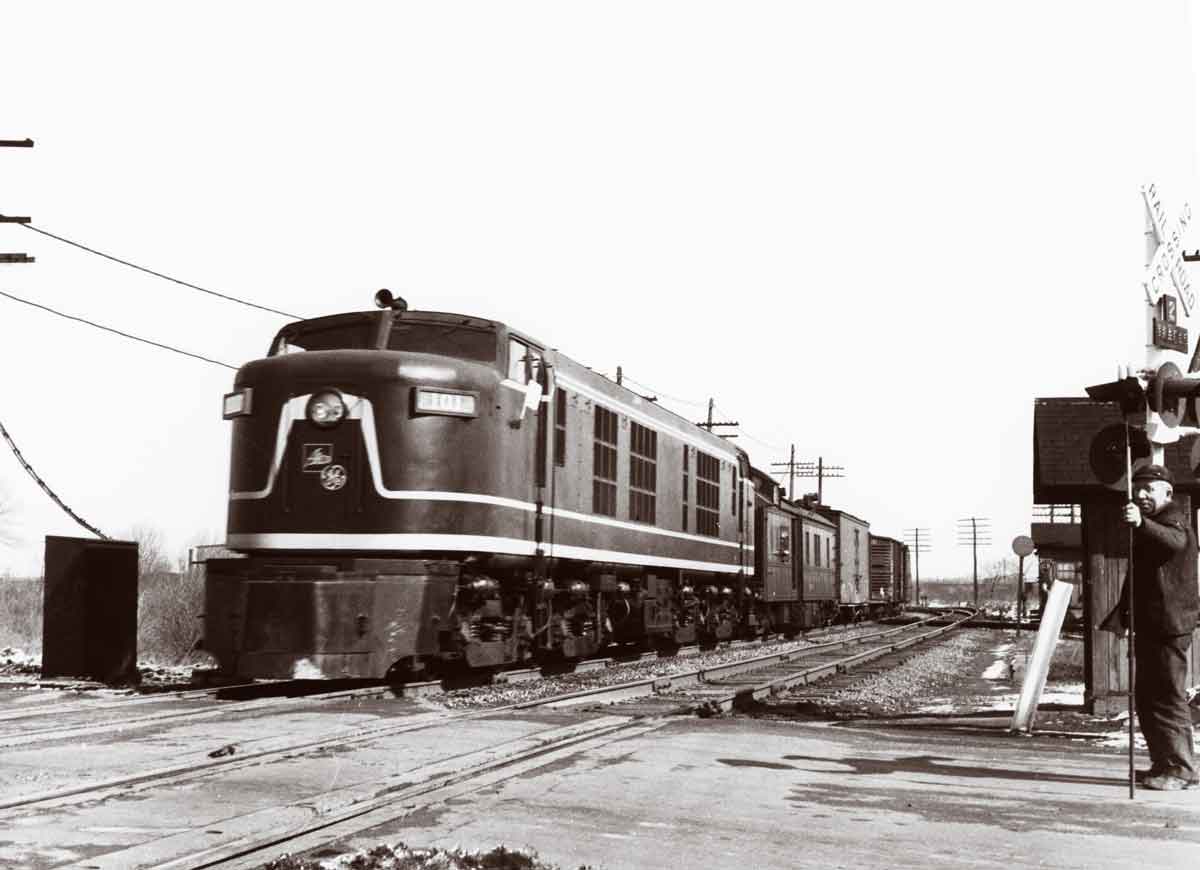
A first-generation GTEL on the head of a freight train at Emkay, Wyoming. Mechanically these were identical to prototype #50, with span-bolstered B+B trucks and a 4500hp turbine/generator combo, but Union Pacific deleted the second cab to install a larger fuel tank onboard. Later on, Union Pacific took the 18-C Vanderbilt tenders from retired 9000-series 4-12-2s, cut off the coal bunker and the water compartment from a second retired 18-C tender, providing a cylindrical tank that was the same diameter from front to rear. These were then paired up with both the first- and second-generation turbines to extend their range even further. The very first auxiliary tender that they built was actually built from a tender off an FEF-1 Northern, #806, and was slightly larger.
After the success of the first fifteen gas turbine electrics, Union Pacific returned for another ten of identical specs. These had walkways cut out of the sides of the carbody though, which earned them the nickname of "Verandas". The #65 is shown with one of the auxiliary tenders built out of a 9000-series steam locomotive tender, and is lending an assist to either a Big Boy or a Challenger. Hard to tell from this angle and I can't make out the numberboard. When the first- and second-generation GTELs were retired in the late '60s and early '70s, they were traded into GE, where the span-bolstered trucks and traction motors were harvested and reused underneath the big twin-engine GE U50s. Some of the auxiliary fuel tanks still exist, with a handful of them being used for fuel storage at Cheyenne after the retirment of the GTELs and a few of them then being repurposed for use as canteen cars behind UP #844, #985 and #4014

After the delivery of the first-generation units in 1953 and the "Verandas" in 1954, Union Pacific placed an order for an even larger and more powerful GTEL from GE. These third-generation units, nicknamed "Big Blows", were delivered between 1958 and 1961. Whereas the 2nd-generation units were mechanically identical to the first-generation units, the third-generation turbines were a completely new beast. They were delivered as a 3-unit A-unit/B-unit/tender set, with two C-trucks under the A- and B-units. The A-unit carried the cab and all the controls, as well as an auxiliary Cooper-Bessemer diesel engine and generator that could be used to move the locomotive around the yard and facilities without firing up the turbine. The B-unit carried an all-new GE Frame 5 simple-cycle gas turbine with a sixteen-stage compressor, ten combustion chambers and a two-stage turbine, which was rated at 8500hp at a 6,000-foot altitude and 90 °F. The turbine was capable of 10,000hp at lower altitudes and cooler temperatures, but the electrical system was not up to handling that kind of output. When the turbine was running, it provided power to the traction motors on both the A- and B-unit. There were mentions of UP applying electric motors to the tender axles to allow them to operate at 10,000hp, such as Trains Magazine saying that the turbines' four-month trial to Los Angeles in 1962 ended when "tender wheels were motorized, imposing speed restriction", but there is a lack of actual evidenced of the tenders being motorized, and there are questions of whether you could even fit traction motors in the GSC and Buckeye trucks under the tenders. Even rated at 8500hp though, the "Big Blows" set the record for the highest-horsepower single prime mover locomotive, and it doesn't look like that record will be challenged anytime soon.
In addition to the nickname "Big Blows", they also earned the moniker of "Bird Roasters". There are tales of them rolling under bridges and flocks of pigeons that had taken refuge under there dropping dead from the heat, noise, and shockwaves. There is also a famous tale of one of them getting stopped for a signal underneath a highway overpass in Cheyenne for an extended period of time. The engineer happened to look back and saw lots of black stuff flying in the air. The heat from the exhaust was melting the asphalt on the overpass, which was then running off the sides, falling into the exhaust of the turbine and getting blown back skyward.
While the prototype unit, and all of the first- and second-generation GTELs were scrapped, two of the third-generation units were preserved. After retirement in 1970, the #18 and #26 were stored serviceable at Cheyenne. They were then sent to Intercontinental Engineering in Riverside, Missouri for scrapping along with many of their other sister units. Supposedly the #18A was used at Intercontinental Engineering as a switcher in the 1970s using the 6-cylinder diesel and the two front traction motors until those failed. The #18 and #26 were saved by museums, with #26 going to the Utah State Railroad Museum in Ogden, Utah, and the #18 originally being donated to Kansas City Railroad Museum before being sold off to Illinois Railway Museum. There are no plans for them to be restored to operation at this time.

You'll need to log in to post.